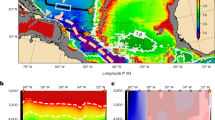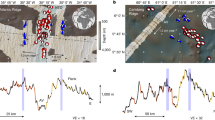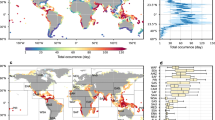Abstract
The last deglaciation (21 to 7 thousand years ago) was punctuated by several abrupt meltwater pulses, which sometimes caused noticeable climate change1,2. Around 14 thousand years ago, meltwater pulse 1A (MWP-1A), the largest of these events, produced a sea level rise of 14–18 metres over 350 years3. Although this enormous surge of water certainly originated from retreating ice sheets, there is no consensus on the geographical source or underlying physical mechanisms governing the rapid sea level rise4,5,6. Here we present an ice-sheet modelling simulation in which the separation of the Laurentide and Cordilleran ice sheets in North America produces a meltwater pulse corresponding to MWP-1A. Another meltwater pulse is produced when the Labrador and Baffin ice domes around Hudson Bay separate, which could be associated with the ‘8,200-year’ event, the most pronounced abrupt climate event of the past nine thousand years7. For both modelled pulses, the saddle between the two ice domes becomes subject to surface melting because of a general surface lowering caused by climate warming. The melting then rapidly accelerates as the saddle between the two domes gets lower, producing nine metres of sea level rise over 500 years. This mechanism of an ice ‘saddle collapse’ probably explains MWP-1A and the 8,200-year event and sheds light on the consequences of these events on climate.
This is a preview of subscription content, access via your institution
Access options
Subscribe to this journal
Receive 51 print issues and online access
$199.00 per year
only $3.90 per issue
Buy this article
- Purchase on Springer Link
- Instant access to full article PDF
Prices may be subject to local taxes which are calculated during checkout




Similar content being viewed by others
References
Clark, P. U. Freshwater forcing of abrupt climate change during the last glaciation. Science 293, 283–287 (2001)
Bond, G. et al. Correlations between climate records from North-Atlantic sediments and Greenland ice. Nature 365, 143–147 (1993)
Deschamps, P. et al. Ice-sheet collapse and sea-level rise at the Bolling warming 14,600 years ago. Nature 483, 559–564 (2012)
Carlson, A. E. Geochemical constraints on the Laurentide Ice Sheet contribution to meltwater pulse 1A. Quat. Sci. Rev. 28, 1625–1630 (2009)
Clark, P. U., Mitrovica, J. X., Milne, G. A. & Tamisiea, M. E. Sea-level fingerprinting as a direct test for the source of global meltwater pulse IA. Science 295, 2438–2441 (2002)
Tarasov, L., Dyke, A. S., Neal, R. M. & Peltier, W. R. A data-calibrated distribution of deglacial chronologies for the North American ice complex from glaciological modeling. Earth Planet. Sci. Lett. 315–316, 30–40 (2012)
Barber, D. C. et al. Forcing of the cold event of 8,200 years ago by catastrophic drainage of Laurentide lakes. Nature 400, 344–348 (1999)
Dyke, A. S. An outline of North American deglaciation with emphasis on central and northern Canada. Dev. Quat. Sci. 2, 373–424 (2004)
Thornalley, D. J. R., McCave, I. N. & Elderfield, H. Freshwater input and abrupt deglacial climate change in the North Atlantic. Paleoceanography 25, PA1201 (2010)
Aharon, P. Entrainment of meltwaters in hyperpycnal flows during deglaciation superfloods in the Gulf of Mexico. Earth Planet. Sci. Lett. 241, 260–270 (2006)
Stanford, J. D. et al. Timing of meltwater pulse 1a and climate responses to meltwater injections. Paleoceanography 21, PA4103 (2006)
Menviel, L., Timmermann, A., Timm, O. E. & Mouchet, A. Deconstructing the Last Glacial termination: the role of millennial and orbital-scale forcings. Quat. Sci. Rev. 30, 1155–1172 (2011)
Weaver, A. J., Saenko, O. A., Clark, P. U. & Mitrovica, J. X. Meltwater pulse 1A from Antarctica as a trigger of the Bølling-Allerød warm interval. Science 299, 1709–1713 (2003)
Rutt, I. C., Hagdorn, M., Hulton, N. R. J. & Payne, A. J. The Glimmer community ice sheet model. J. Geophys. Res. 114, F02004 (2009)
Peltier, W. R. Global glacial isostasy and the surface of the ice-age Earth: the ice-5G (VM2) model and GRACE. Annu. Rev. Earth Planet. Sci. 32, 111–149 (2004)
Munyikwa, K., Feathers, J. K., Rittenour, T. M. & Shrimpton, H. K. Constraining the Late Wisconsinan retreat of the Laurentide ice sheet from western Canada using luminescence ages from postglacial aeolian dunes. Quat. Geochronol. 6, 407–422 (2011)
Hanebuth, T., Stattegger, K. & Grootes, P. M. Rapid flooding of the Sunda shelf: a late-glacial sea-level record. Science 288, 1033–1035 (2000)
Stanford, J. D. et al. Sea-level probability for the last deglaciation: a statistical analysis of far-field records. Glob. Planet. Change 79, 193–203 (2011)
Bard, E., Hamelin, B. & Fairbanks, R. G. U-Th ages obtained by mass spectrometry in corals from Barbados: sea level during the past 130,000 years. Nature 346, 456–458 (1990)
Fulton, R. J., Ryder, J. M. & Tsang, S. The Quaternary glacial record of British Columbia, Canada. Dev. Quat. Sci. 2, 39–50 (2004)
Davies, M. H. et al. The deglacial transition on the southeastern Alaska margin: meltwater input, sea level rise, marine productivity, and sedimentary anoxia. Paleoceanography 26, 18 (2011)
Tarasov, L. & Peltier, W. R. A calibrated deglacial drainage chronology for the North American continent: evidence of an Arctic trigger for the Younger Dryas. Quat. Sci. Rev. 25, 659–688 (2006)
Teller, J. T., Leverington, D. W. & Mann, J. D. Freshwater outbursts to the oceans from glacial Lake Agassiz and their role in climate change during the last deglaciation. Quat. Sci. Rev. 21, 879–887 (2002)
Murton, J. B., Bateman, M. D., Dallimore, S. R., Teller, J. T. & Yang, Z. Identification of Younger Dryas outburst flood path from Lake Agassiz to the Arctic Ocean. Nature 464, 740–743 (2010)
Weertman, J. Stability of ice-age ice sheets. J. Geophys. Res. 66, 3783–3792 (1961)
Li, Y.-X., Törnqvist, T. E., Nevitt, J. M. & Kohl, B. Synchronizing a sea-level jump, final Lake Agassiz drainage, and abrupt cooling 8200 years ago. Earth Planet. Sci. Lett. 315–316, 41–50 (2012)
Rohling, E. J. & Palike, H. Centennial-scale climate cooling with a sudden cold event around 8,200 years ago. Nature 434, 975–979 (2005)
Payne, A. & Sugden, D. Topography and ice sheet growth. Earth Surf. Process. Landf. 15, 625–639 (1990)
Smith, R. S., Gregory, J. M. & Osprey, A. A description of the FAMOUS (version XDBUA) climate model and control run. Geosci. Model Dev. 1, 53–68 (2008)
Gregoire, L. Modelling the Northern Hemisphere Climate and Ice Sheets During the Last Deglaciation. PhD thesis, Univ. Bristol. (2010)
Marshall, S. J., James, T. S. & Clarke, G. K. C. North American ice sheet reconstructions at the Last Glacial Maximum. Quat. Sci. Rev. 21, 175–192 (2002)
Charbit, S., Ritz, C., Philippon, G., Peyaud, V. & Kageyama, M. Numerical reconstructions of the Northern Hemisphere ice sheets through the last glacial-interglacial cycle. Clim. Past 3, 15–37 (2007)
Zweck, C. & Huybrechts, P. Modeling of the Northern Hemisphere ice sheets during the last glacial cycle and glaciological sensitivity. J. Geophys. Res. 110, 103–127 (2005)
Ganopolski, A., Calov, R. & Claussen, M. Simulation of the last glacial cycle with a coupled climate ice-sheet model of intermediate complexity. Clim. Past 6, 229–244 (2010)
North Greenland Ice Core Project High-resolution record of Northern Hemisphere climate extending into the last interglacial period. Nature 431, 147–151 (2004)
Amante, C. & Eakins, B. W. ETOPO1 1 Arc-Minute Global Relief Model: Procedures, Data Sources and Analysis (NOAA Technical Memorandum NESDIS NGDC-24, 2009); available at http://www.ngdc.noaa.gov/mgg/global/relief/ETOPO1/docs/ETOPO1.pdf
Laske, G. & Masters, G. A global digital map of sediment thickness. Eos 78, F483 (1997)
Le Meur, E. & Huybrechts, P. A comparison of different ways of dealing with isostasy: examples from modelling the Antarctic ice sheet during the last glacial cycle. Ann. Glaciol. 23, 309–317 (1996)
Reeh, N. Parameterization of melt rate and surface temperature in the Greenland ice sheet. Polarforschung 59, 113–128 (1991)
Abe-Ouchi, A., Segawa, T. & Saito, F. Climatic conditions for modelling the Northern Hemisphere ice sheets throughout the ice age cycle. Clim. Past 3, 423–438 (2007)
Spahni, R. et al. Atmospheric methane and nitrous oxide of the Late Pleistocene from Antarctic ice cores. Science 310, 1317–1321 (2005)
Berger, A. & Loutre, M. F. Astronomical solutions for paleoclimate studies over the last 3 million years. Earth Planet. Sci. Lett. 111, 369–382 (1992)
Peltier, W. R. & Fairbanks, R. G. Global glacial ice volume and Last Glacial Maximum duration from an extended Barbados sea level record. Quat. Sci. Rev. 25, 3322–3337 (2006)
Acknowledgements
This work was supported by the Marie Curie Research Training Network NICE (MRTN-CT-2006-036127) and the NERC QUEST (NE/D001846/1) and ORMEN (NE/C509558/1) projects. Glimmer was developed within the NERC National Centre for Earth Observation. We thank R. Kahana for providing part of the input climate data and for comments on the manuscript. We also thank members of the BRIDGE group, the NICE network and PALSEA, a PAGES/INQUA/WUN network, for discussions and suggestions. The numerical simulations were carried out using the computational facilities of the BRIDGE group and those of the Advanced Computing Research Centre, University of Bristol (http://www.bris.ac.uk/acrc/).
Author information
Authors and Affiliations
Contributions
L.J.G. performed the experiments, the analysis and wrote the manuscript. P.J.V. provided the input climate. All authors contributed to designing the experiments, discussed the results and implications and commented on the manuscript at all stages.
Corresponding author
Ethics declarations
Competing interests
The authors declare no competing financial interests.
Supplementary information
Supplementary Information
This file contains Supplementary Table 1, Supplementary Figures 1-5, Supplementary References and a Supplementary Discussion, which provides a comparison of the modelled North American deglaciation with data and describes additional experiments referred to in the main text. (PDF 820 kb)
Supplementary Movie 1
This movie shows the evolution of ice elevation, surface mass balance and meltwater flux of the North American ice sheet through the last deglaciation. The two meltwater pulses happen when ice domes separate. The pulses are associated with an extension of the ablation area (area where melting is higher than snow accumulation) in the saddle between multiple ice domes. (MOV 5679 kb)
Rights and permissions
About this article
Cite this article
Gregoire, L., Payne, A. & Valdes, P. Deglacial rapid sea level rises caused by ice-sheet saddle collapses. Nature 487, 219–222 (2012). https://doi.org/10.1038/nature11257
Received:
Accepted:
Published:
Issue Date:
DOI: https://doi.org/10.1038/nature11257
This article is cited by
-
Dampened predictable decadal North Atlantic climate fluctuations due to ice melting
Nature Geoscience (2023)
-
Enhanced subglacial discharge from Antarctica during meltwater pulse 1A
Nature Communications (2023)
-
A gradual change is more likely to have caused the Mid-Pleistocene Transition than an abrupt event
Communications Earth & Environment (2023)
-
Rapid northern hemisphere ice sheet melting during the penultimate deglaciation
Nature Communications (2022)
-
Slow and soft passage through tipping point of the Atlantic Meridional Overturning Circulation in a changing climate
npj Climate and Atmospheric Science (2022)
Comments
By submitting a comment you agree to abide by our Terms and Community Guidelines. If you find something abusive or that does not comply with our terms or guidelines please flag it as inappropriate.



